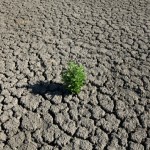Feds Open Up Conservation Land To Drought-Stricken Ranchers

Mose Buchele for StateImpact Texas.
Land set aside as part of the USDA's Conservation Reserve Program will be used to produce hay under the new plan.
Farmers and ranchers will be allowed to graze cattle and grow hay on land typically reserved for conservation under an initiative announced by the US Department of Agriculture on Monday. US Secretary of Agriculture Tom Vilsack told reporters that the move aims to increase the food supply for cattle in parts of the country gripped by this year’s drought .
Under the initiative, land that is part of the USDA’s Conservation Reserve Program [CRP] in counties designated as drought-stricken or abnormally dry can be used to produce cattle feed. That’s an expansion of an emergency drought plan announced last week that opened up CRP land in areas stricken by severe drought.
“All counties in the country which are currently on the drought monitor as being somewhere between abnormally dry to extremely dry will now be included in the emergency haying and grazing effort,” Vilsack told reporters.
About 87 percent of the state of Texas is listed as abnormally dry or worse according to the latest drought monitor map.
The Conservation Reserve Program pays rental fees and provides financial assistance to land owners who agree to keep some of their land uncultivated. The program aims to curb erosion by allowing natural growth on large sections of land. Vilsack said landowners that opt to grow hay or graze cattle on CRP land this year will need to return ten percent of the rental fee they receive from the government.
While some may worry about the environmental impact of opening up CRP land, others question whether drought-stricken CRP land will be able to provide much extra cattle feed in the first place.
To that second question, Vilsack says the new initiative will also allow landowners to sell hay grown on dry CRP land to ranchers in other parts of the country, something that could help in areas where CRP land is as drought-stricken as regular pastureland.
The View from Texas
This is not the first time CRP land has been opened to ranchers. Carmen Fenton, Director of Public Affairs with the Texas and Southwestern Cattle Raisers Association, told StateImpact Texas that a similar program went into effect in Texas during last year’s drought.
Fenton expects the new initiative will help to bring more hay “into the chain” for Texas ranchers who continue to suffer under dryer than normal conditions.
“We don’t know exactly which counties are going to be open for this, so we don’t know to what extreme it’s going to benefit Texas, but I’m sure that in some way it will be helpful,” said Fenton.
Another factor that may ease cattle-feeding worries in Texas this summer? The fact that the state began experiencing drought a year earlier than much of the rest of the country. Because of that, ranchers had already sold off much of their herds ahead of this summer.
“There’s a lot less cattle now so the little bit of hay production that we are making can kind of cover that cattle needs here,” Elgin Rancher Brent Johnson told StateImpact Texas last month.
“But the hay fields aren’t doing very good at all,” he added.



